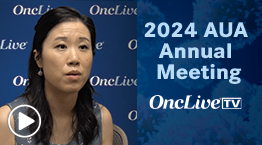Phase 3 ASCENT Trial in mTNBC
EP: 1.Standard of Care for Early-Stage TNBC
EP: 2.Role of pCR in Early Stage TNBC Management
EP: 3.Key Trials in ICI-Based Therapy for Early Stage TNBC
EP: 4.Early Stage TNBC: Phase 3 IMpassion031 Study
EP: 5.Role of Immune Checkpoint Inhibitor-Based Therapy in ES TNBC
EP: 6.ICI-Based Therapy in TNBC: Immune-Related Adverse Events
EP: 7.Emerging Data on Biomarkers in ES TNBC
EP: 8.Current Trials for Treatment of Early Stage TNBC
EP: 9.Standard of Care for Metastatic TNBC
EP: 10.KEYNOTE-355 Trial in mTNBC
EP: 11.Testing for PD-L1 Expression in mTNBC
EP: 12.Standard of Care for BRCA+ mTNBC
EP: 13.Sequencing Therapies for mTNBC
EP: 14.Phase 3 ASCENT Trial in mTNBC
EP: 15.Phase 3 ASCENT Trial in mTNBC: Managing Adverse Events
EP: 16.Future Directions for Treatment of TNBC
Joyce A. O’Shaughnessy, MD: Let’s turn to the very important new data that came out of ESMO [European Society for Medical Oncology Congress], because we have a new survival impact for our metastatic triple negatives. Adam, you were an investigator in a sense, can you tell us about that?
Adam M. Brufsky, MD, PhD: Well, we were all on the paper. The bottom line is that it’s uncommon in our business to actually have in the third line a disease that really was refractory to a lot of stuff in survival benefit. And this is pretty cool. I’ll go quickly because there’s a lot we want to talk about. The bottom line is ASCENT was 529 patients. Sacituzumab is a monoclonal antibody to the Trop-2 antigen, and it has a cleavable linker to SN-38. That is an irinotecan derivative, which is a Trop-1 inhibitor. It was 529 patients who were randomized 1:1 to sacituzumab, day 1 and 8 of every 21-day cycle vs physician’s treatment of choice. I think it was eribulin, capecitabine, or gemcitabine, and then there were some other ones, but the bottom line is it was physician’s choice of therapy.
Just to give you the top-line data, the prior anticancer regimens was a median of 4. I think that did include adjuvant therapy. They were the typical ones we thought of, but it was 4. They had at least 2 lines in the metastatic setting, probably 2 to 3 lines. There were some patients who had up to 17 lines, which is surprising. But the bottom line is the progression-free survival went from 1.7, and that’s really important. That 1.7 number is now the baseline. It’s the standard of care that we can use now when we start evaluating other agents in the third-line setting in triple-negative disease.
Everybody is progressing. It’s 1.7 from the time you get the next scan. But it was increased to 5.6, and that’s gratifying because that pretty much was what we saw in the phase 2 trial, so it replicated that. But the most important part of this was the overall survival benefit, which went from 6.7 months to 12.1 months. It had a hazard ratio of 0.5 in a previously intractable disease. There were better response rates, and the overall response was 82% vs 11% with the physician’s standard of care, which is what we all expect.
I don’t know if we’re supposed to talk about the adverse events that are predominantly hematologic and diarrhea. I think we will talk about that in a bit. But the bottom line is that the hazard ratio…went in favor of sacituzumab. This is pretty good data. It is pretty solid, and it really represents a standard of care. There is a reason that Gilead Sciences, Inc bought Immunomedics for $21 billion.
Joyce A. O’Shaughnessy, MD: That’s a good point. There you go. That speaks volumes.
Adam M. Brufsky, MD, PhD: Obviously this is going to be expanded to the ER [estrogen receptor]–positive setting. I think we are all probably investigators on a TROPICS trial. But the bottom line is this: How often do we see this? It’s pretty dramatic. I wonder what the holes are in this study.
Joyce A. O’Shaughnessy, MD: I don’t know. Sara, are there any holes? I guess we’ve got accelerated approval, is that right? What do you think will happen going forward, and how do you incorporate sacituzumab? We’ve had it under accelerated approval. What do you think overall about this?
Sara A. Hurvitz, MD: I think it’s really exciting. The accelerated approval and Adiyta Bardia’s data were really quite nice. We saw the 35% or so objective response rate in heavily pretreated triple-negative breast cancer. We were so wanting some sort of positive data with a therapy like this in heavily pretreated triple-negative disease that we all leaped to use it without randomized data. I didn’t dream these data were going to be this good, and I was really excited when we saw that it was not just PFS [progression-free survival] but OS [overall survival]. But I do want to call out how horribly patients do with single-agent chemotherapy in the control arm. What we see in practice underscores how bad the outcome is in the second-, third-, fourth-, and fifth-line setting for triple-negative disease.
It’s great for patients. I’m incorporating it now in the third line setting and have been since the approval. I am tempted to use it in the second-line setting in the patient, especially for someone whose tumor is not PD-L1 positive or who has had a fast relapse. I’m trying to move it up a little, but this is an area where we’re going to see it move up, and we’re going to see different combination strategies as well. It highlights how important clinical trials are in this setting and in patients who are heavily pretreated.
Joyce A. O’Shaughnessy, MD: Thank you so much. Kevin, can you tell us a little more about kind of what sacituzumab is? Why was it so dramatically not cross resistant in this heavily pretreated population?
Kevin M. Kalinsky, MD: Sacituzumab govitecan targets Trop-2, which is expressed on epithelial cells. Going back to the point that Adam made, we’re seeing benefits with this drug. Not just in triple-negative breast cancer, hormone receptor positive, HER2 negative—those data have been published—but in urothelial cancer, lung cancer, etc. It’s a protein that can be broadly expressed. It’s linked with a stable linker to SN-38, the topoisomerase inhibitor. To the question that you had posed, in terms of cross-resistance, 1 of the things is that the payload is a different class of antineoplastic agents compared with taxanes, anthracyclines, etc. This subsequently has different toxicity profiles as well.
That’s part of why we’re seeing this nice activity a little later on. Just to reiterate 1 of the points that was previously raised, we’ve been in circumstances in which we’ve seen great data in phase 2 studies that unfortunately don’t always translate into phase 3 trials. The phase 2 data were published, and we’re also seeing a great response rate. We see this exact same response rate of about a third in this phase 3 trial. So it was nice to see these data in a randomized setting.
Joyce A. O’Shaughnessy, MD: Thank you.
Transcript Edited for Clarity



